Real-time adjustments may help reduce bothersome dyskinesias

Can refinement of deep brain stimulation (DBS) programming provide better motor control for some patients with Parkinson’s disease?
That’s the question at the heart of newly published research reporting on the safety, tolerability and efficacy of adaptive DBS (aDBS) among participants who had been doing well on traditional continuous DBS (cDBS) with medication. The international open-label trial, Long-Term Personalized Adaptive Deep Brain Stimulation in Parkinson Disease (ADAPT-PD), was published recently in JAMA Neurology. Movement disorders specialist Michal Gostkowski, DO, led Cleveland Clinic’s participation in the study.
Advertisement
Cleveland Clinic is a non-profit academic medical center. Advertising on our site helps support our mission. We do not endorse non-Cleveland Clinic products or services. Policy
Forty-five participants were evaluated in either one or both of two aDBS modes — single or dual threshold. The primary end point goal of at least 50% symptom-control “on” time was met. All but one stimulation-related adverse effect (AEs) resolved during the aDBS setup and adjustment period. There were no serious device AEs through long-term follow-up.
The study found that long-term aDBS was safe, effective and tolerable for the participants, who previously were stable on continuous DBS and medication.
“The most important message from the study is that aDBS is just another tool for patients who need it,” says Dr. Gostkowski. “It's very helpful. Not every patient will need this, but those who do will find it very helpful.”
The FDA approved deep brain stimulation for Parkinson’s in 2002, and since then thousands of people worldwide have undergone implant surgery to help them with stiffness and tremors that were no longer being controlled pharmacologically. The technology uses electrodes to stimulate regions of the brain affected by the disease, typically the subthalamic nucleus and globus pallidus interna. The electrodes are connected to a pulse generator implanted in the chest.
Traditional DBS is programmed to provide continuous stimulation at a rate clinicians set based on their assessment of the patient’s needs. The technology has facilitated game-changing symptom control for some people, but it can cause disruptive dyskinesias as the patient experiences increased or decreased neurostimulation throughout the day due to changing emotions, activity levels and medications.
Advertisement
With an aim to reduce or eliminate dyskinesias and symptom control “off” time, researchers developed a commercially available closed-loop DBS system (Medtronic’s Percept™ PC) that records fluctuations in stimulation and uses the data to adjust Parkinson’s-related frequencies in real time.
“When you take a patient and program them for continuous DBS, you're taking a best guess of what will be a good setting to have all the time,” says Dr. Gostkowski. “Medication offers symptom control benefit, but if they're getting too much stimulation, they're going to have bothersome dyskinesia.”
But adaptive DBS is programmed using a personalized neural physiomarker and by setting either upper (single threshold) neurostimulation limits or upper and lower (dual threshold) limits.
“As patients go throughout their day, if a certain frequency increases, they get more stimulation to smooth out the Parkinson's symptoms and keep them stable,” Dr. Gostkowski says. “The goal of adaptive DBS is that as the Parkinson's symptoms are there, or the dyskinesias come on, you can adjust and get a very steady effect.”
Before ADAPT-PD, small trials had assessed short-term efficacy of aDBS in clinical settings. The aim of ADAPT-PD was to gather data on how the technology performed in a real-world setting and whether it delivered symptom control comparable to cDBS; it did. Forty of the 45 ADAPT-PD trial participants who completed the study chose to take advantage of extended access to the aDBS technology.
“Our patients have been responding very well to it,” says Dr. Gostkowski. “They like the flexibility. They that their symptoms are really not having big peaks and valleys.”
Advertisement
In addition to receiving more stabilized stimulation, Dr. Gostkowski notes that aDBS technology enables patients to receive only the amount of help needed to control symptoms.
“My osteopathic thought is always ‘less medication.’ Deep brain stimulation is medication,” he says. “If you can get by giving someone a little bit less, that's a good benefit.”
As aDBS becomes more widely used, Dr. Gostkowski says it is important to keep in mind that it is just another tool for patients who need it. Not everyone will.
“Patients have been helped by deep brain stimulation for Parkinson's since 2002 and have done very well,” he says. “People may have the perception that DBS hasn’t been working until now, but it has been working very well.”
Advertisement
Advertisement

Tasked-based therapy improves social connection and quality of life

Novel approach dramatically reduces the need for real-world data

Large analysis of familial cases and genomic studies sheds light on genetic contributions

Systems genetics approach sets stage for lab testing of simvastatin and other candidate drugs

Research project will leverage insights into neural circuits to advance DBS technology

Randomized trial demonstrates noninferiority to therapist-led training

Study reveals heavy care burden, missed opportunities in patients with uncontrolled symptoms on oral therapy

Also will assess ability of high-intensity exercise to offset the cognitive decline